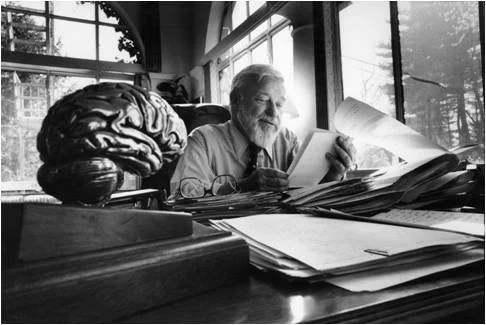The History of Glenn Doman’s How to Teach Your Baby to Read
My father, Glenn Doman, understood a simple truth: babies can read. For centuries, mothers and grandmothers have taught their babies to read, and Glenn Doman was no different. His mother taught him to read when he was just three years old. Inspired by this early understanding of childhood literacy, Glenn Doman went on to create the Doman Method Reading Program and write How to Teach Your Baby to Read.
The Doman Reading Program Began with Children with Special Needs
The beginnings of the Doman Method Reading Program are rooted in Glenn Doman’s lifelong dedication to helping children with special needs. Part of Glenn’s work focused particularly on children with cerebral palsy, recognizing that their midbrain injuries affected movement, balance, and speech but left their cortex intact, the part of the brain responsible for thought, perception, and memory, and important for reading.
In the 1950s, when Glenn Doman was working on the Doman Method, the greater medical community felt that people with these disabilities were not capable of great potential. To put it bluntly, they looked down on them. Glenn was adamant about proving them wrong and showing that no matter the child’s neurological condition, they too could learn and be a part of society. Because of this determination, he focused particularly on children with cerebral palsy, believing their reading success could challenge prevailing medical beliefs.
In the late 1950s, he found that proof in Tommy, a child with cerebral palsy who, at the age of three, was able to read. Meeting Tommy confirmed what Glenn Doman had long suspected: even children with special needs, if taught in the right way, could learn to read.
Glenn Doman Flash Cards and the Visual Word Form Area
Glenn Doman’s understanding of the visual word form area of the brain led him to create the Doman Method Reading Program. The visual word form area is the part of the brain that recognizes words and letters. Glenn Doman needed an alternative way to teach reading since he knew the challenges with phonics, especially for children with special needs. Teaching phonics has many issues that make it difficult for a child with special needs to learn; for instance, it requires verbal skills and motor skills that some children with special needs might not have. However, if the visual word form area could be stimulated in a different way, free from the limitations of phonics, then maybe Glenn Doman could teach kids with special needs to read. That’s how he came to create Doman flashcards.
Example of Doman Flashcards
Children, even those with neurological visual impairments, could learn to read easily when words were presented with high frequency on flashcards with large, bold, and red text. The Glenn Doman Reading Program presents flashcards of the same word multiple times a day, reinforcing learning through repetition, and allowing the visual word form area to recognize the words more easily. This simple yet powerful approach paved the way for hundreds of thousands of children with special needs to read for the first time.
Expanding the Reading Program – From Kids with Special Needs to All Children
As Glenn continued to refine the Doman Reading Program, he noticed something interesting: parents of children with special needs reported that their younger children began reading too. These siblings usually learned alongside their brother or sister with special needs, and ended up showing that the Doman Method worked universally, not just for children with special needs.
Glenn expanded his program to include neurotypical children, creating a step-by-step guide that began with single-word flashcards, moved to couplet flashcards, and then advanced to short sentences and Doman Books. This universal success inspired Glenn Doman’s broader vision, and his reading method eventually became the foundation for his landmark book, How to Teach Your Baby to Read.
The Birth of How to Teach Your Baby to Read
In 1962, Glenn Doman took a brief “vacation” to write the book that would change the lives of many children. Despite opposition from colleagues over the controversial use of the word “baby” in the title, Glenn remained committed to the idea that babies, even as young as one year old, could learn to read. He wrote How to Teach Your Baby to Read in just two weeks. The book went on to become a New York Times Bestseller and launched what Glenn would call the “Gentle Revolution.”
The Gentle Revolution: Glenn Doman’s Early Reading Legacy
Glenn’s vision of early reading created a movement that would shape generations. The Gentle Revolution that Glenn Doman started has now changed the lives of millions of children worldwide. His vision of teaching babies to read early in life profoundly shaping their future success, continues to inspire parents today. His method, focusing on big, bold, red words, high-frequency repetition, and joyful teaching, has remained at the forefront of early childhood literacy.
As Glenn Doman wrote in the final paragraph of his book How to Teach Your Baby to Read:
“Little children have begun to read and thus to increase their knowledge, and if this book leads only one child to reading sooner and better, then it would have been worth the effort. Who can say what another superior child will mean to the world? Who is to say what, in the end, would be the sum total of good for men as a result of this quiet ground swell which has already begun, this gentle revolution.”
Today, the Gentle Revolution continues, and more than 60 years later, the Glenn Doman Method continues to empower parents to teach their babies to read, ensuring that generations to come will benefit from his groundbreaking work in early education.
If you have a child with special needs please check out Doman International, the non-profit dedicated to helping kids with special needs using the Doman Method. If you are here to just teach your baby to read, do math, and love learning then check out the Premium Doman Bundle - it’s everything you need to start your child’s early education.








